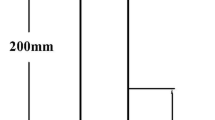Abstract
The quench sensitivity and their influential factors of 7,021, 7,085, and 7,050 alloys were investigated by the end quenching test method and the measurement of electrical conductivity, hardness, and microstructure after aging. The results indicate that 7,050 alloy has the largest changes with hardness decreasing from HV 199 to HV 167, and electrical conductivity increases from 16.6 to 18.2 MS·m−1 when the distance from quenched end increases from 2 to 100 mm. Alloys 7,085 and 7,021 have relatively smaller changes. According to the relationship between the hardness and electrical conductivity of a supersaturated solid solution, 7,050 alloy has higher quench sensitivity than 7,085 and 7,021 alloys. The microstructure of 7,050 alloy with higher major alloy element (Zn + Mg + Cu) addition and Cu element addition is mostly affected by the changes of distance from quenched end. In 7,050 alloy, the size of intragranular precipitates is from about 10–200 nm, and the (sub) grain boundary precipitates are about 20–300 nm. Alloy 7,085 with lower Cu content is moderately affected, while 7,021 is least affected. It is found that with the increase of distance from quenched end, quenched-induced precipitate preferentially nucleates and grows in the (sub) grain boundary and then on the pre-existing Al3Zr particles.





Similar content being viewed by others
References
Xiong BQ, Li XW, Zhang YA, Li ZH, Zhu BH, Wang F, Liu HW. Quench sensitivity of Al–Zn–Mg–Cu alloys. Chin J Nonferrous Metals. 2011;21(10):2631.
Li ZH, Xiong BQ, Zhang YA, Zhu BH, Wang F, Liu HW. Microstructure and properties of 7B04 Al alloy pre-stretched thick plates. Chin J Rare Met. 2007; 31(4):440.
Eskin DG. Decomposition of supersaturated solid solutions in Al–Cu–Mg–Si alloys. J Mater Sci. 2003;38(2):279.
Farber VM. Initial stages of decomposition of supersaturated solid solutions. Met Sci Heat Treat. 1995;37(10):391.
Chakrabarti DJ, Liu J, Sawtell RR, Venema GB. New generation high strength high damage tolerance 7085 thick alloy product with low quench sensitivity. In: Proceedings of the 9th International Conference on Aluminum Alloys, Vancouver, 2004:969.
Thompson DS, Subramanya BS, Levy SA. Quench rate effects in Al–Zn–Mg–Cu alloys. Metall Trans. 1971;2(4):1149.
Yan L-M, Shen J, Li J-P, Mao B-P. Static softening behaviors of 7055 alloy during the interval time of multi-pass hot compression. Rare Met. 2013;32(3):241.
Conserva M, Dirusso E, Caloni O. Comparison of the influence of chromium and zirconium on the quench sensitivity of Al–Zn–Mg–Cu alloys. Metall Trans. 1971;2(4):1227.
Conserva M, Fiorini P. Interpretation of quench-sensitivity in Al–Zn–Mg–Cu alloys. Metall Trans. 1973;4(3):857.
Zhang DL, Zheng L. The quench sensitivity of cast Al–7Si–0.4Mg alloy. J Metall Mater Trans A. 1996;27(10):3983.
Chen Tsung-Rong, Peng Guan-Jye, Huang JC. Low quench sensitivity of superplastic 8090 Al–Li thin sheets. Metall Mater Trans A. 1996;27(10):2923.
Tiryakioglu Murat, Ralph Shuey T. Quench sensitivity of an Al-7 Pct Si-0.6 Pct Mg alloy: characterization and modeling. Metall Mater Trans B. 2007;38(4):575.
Wang XS, Nie B, Xie YC. Effect of heat-treatment institutions on conductivity of 7,075 aluminum alloy. Light Alloy Fabr Technol. 2001;29(7):40.
Xi GR, Zhang JY. Influence of composition on quench sensitivity of aluminum alloy. Light Alloy Fabr Technol. 1994;22(11):36.
Zhang XM, Liu SD, You JH, Zhang C, Zhang XY. Influence of aging on quench sensitivity effect of 7,055 aluminum alloy. Chin J Nonferrous Met. 2007;17(2):394.
Starink MJ, Li XM. A model for the electrical conductivity of peak-aged and overaged Al–Zn–Mg–Cu alloys. Metall Mater Trans A. 2003;34(4):899.
Yu YN. Fundamentals of Science and Engineering. Beijing: Higher Education Press; 2008. 201.
Qi WJ, Wang SC, Chen XM, Nong D, Zhou Z. Effective nucleation phase and grain refinement mechanism of Al–5Ti–1B master alloy. Chin J Rare Met. 2013;37(2):179.
Liscic B, Tensi HM, Canale LCF, Totten GE. Quenching Theory and Technology. 2nd ed. New York: Chemical Rubber Company; 2010. 56.
Zhang XM, Liu SD, You JH, Zhang C, Zhang XY. Influence of aging on quench sensitivity effect of 7,055 aluminum alloy. Chin J Nonferrous Met. 2007;17(2):261.
Liu WJ, Zhang XM, Liu SD, Zhou XW. Effect of homogenization on quenching sensitivity of 7,050 aluminum alloy plates. Chin J Nonferrous Met. 2010;20(6):1103.
Acknowledgments
This work was financially supported by the National Natural Science Foundation of China (No. 51274046).
Author information
Authors and Affiliations
Corresponding author
Rights and permissions
About this article
Cite this article
Zhang, ZH., Xiong, BQ., Liu, SF. et al. Changes of microstructure of different quench sensitivity 7,000 aluminum alloy after end quenching. Rare Met. 33, 270–275 (2014). https://doi.org/10.1007/s12598-014-0258-7
Received:
Revised:
Accepted:
Published:
Issue Date:
DOI: https://doi.org/10.1007/s12598-014-0258-7




